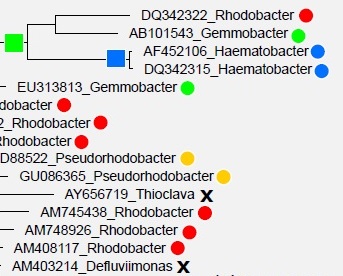 Defining microbial taxa
Defining microbial taxa
See also
Microbial taxonomy
Taxonomic nomenclatures (naming systems)
The SILVA and Greengenes "taxonomies"
The traditional goal of taxonomy has been described as classifying living organisms into a hierarchy of categories (taxa) that are useful (based on biologically informative traits) and monophyletic (consistent with the true phylogenetic tree), though this point of view is not universally accepted.
For example, mammals (a taxonomic class) are defined by characteristic traits such as having a mammary gland, hair, giving birth to live young and being warm-blooded. Lower ranks have these features plus more specific traits. For example, primates (an order within the mammals class) have grasping hands and feet. Humans (a species within the primate order) are primates who study taxonomy.
 In microbial taxonomy, most lower groups, especially species and genera, are defined by traits , Genera and higher groups are usually intended to be consistent with phylogeny , though defining a phylogenetic tree for prokaryotes is conceptually problematic , and in practice trees have many errors .
In microbial taxonomy, most lower groups, especially species and genera, are defined by traits , Genera and higher groups are usually intended to be consistent with phylogeny , though defining a phylogenetic tree for prokaryotes is conceptually problematic , and in practice trees have many errors .
For example, Bergey's Manual gives the characteristic traits of genus Staphylococcus as:
"Cells spherical, 0.5 to 1.5 micrometers in diameter, occurring singly, in pairs, in tetrads, in short chains (3 to 4 cells), and characteristically dividing in more than one plane to form irregular grapelike clusters. Gram-stain-positive. Nonmotile. Resting stages not produced. Cell wall contains peptidoglycan and teichoic acid. The diamino acid present in the peptidoglycan is L-lysine (peptidoglycan group A3). Usually unencapsulated or limited capsule formation."
Species are defined by more specific traits:
"Species identity [within Staphylococcus is made] on the basis of a variety of phenotypic characters such as cell-wall composition, colony morphology, activities and molecular properties of various enzymes, production of acid from various carbohydrates, resistance to certain antibiotics, nutritional and oxygen requirements, cytochrome composition, oxygen requirements, and fatty acid composition."
Ranks at family and above are often defined in practice by giving a list of the lower groups it contains. The lower groups are typically identified on the basis of 16S rRNA sequence similarity. Traits may be described, but are not necessarily considered to define the group (this is usually left unstated). For example, from Bergey's Manual: (emphasis added):
"The family Listeriaceae is circumscribed for this volume on the basis of phylogenetic analyses of the 16S rRNA sequences and includes the genus Listeria and its close relative Brochothrix . Cells are short rods that may form filaments. Cells stain Gram-positive, and the cell walls contain meso-diaminopimelate. The major lipid components include saturated straight-chain and methyl-branched fatty acids. Endospores are not formed. Menaquinones are the sole respiratory quinone. Growth is aerobic and facultative anaerobic, and glucose is fermented to lactate and other products."

